ASRock DeskMini H470 Review: A No-Frills LGA 1200 mini-PC Platform
by Ganesh T S on December 29, 2020 8:00 AM ESTStorage and Networking Performance
Storage and networking are two major aspects which influence the experience with any computing system. This section presents results from our evaluation of the storage aspects in the ASRock DeskMini H470. On this aspect, one option would be repetition of our strenuous SSD review tests on the drive(s) in the PC. Fortunately, to avoid that overkill, UL PCMark 10 has a Full System Drive Benchmark storage test certain common workloads such as booting, loading games, and document processing are replayed on the target drive. The average access times and bandwidth numbers are recorded for each trace and the overall numbers contribute to a benchmark score.
In case of single drive systems, we attempt to allocate 180GB to the primary partition, and leave the remaining space on the drive as a secondary partition. For dual-drive systems, the OS drive is the primary drive, while the other is categorized as the secondary one. Since PCMark 10 requires 80GB of free space at the minimum for processing the Full System Drive Benchmark, we are able to process the benchmark on both the primary and secondary drive in only some of the evaluated systems. The results are presented below.
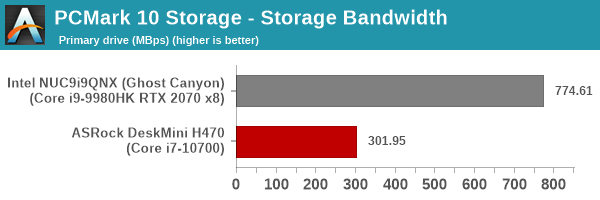
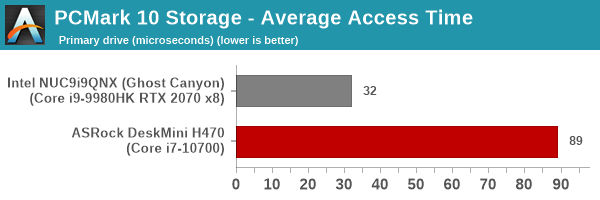
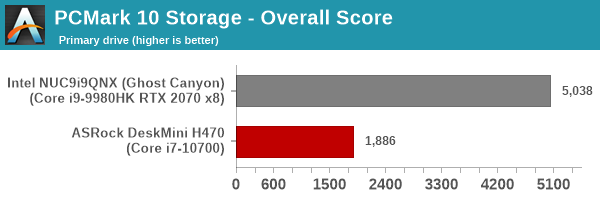
Since the PCMark 10 storage component is a recent addition to our benchmark suite, we only have the Ghost Canyon NUC for comparison. In the battle of primary drives, the Intel SSD 905p Optane drive is against the Crucial P5 with Micron's 96L 3D TLC NAND flash. Commensurate with the cost of the SSDs (~$500 @ around $1.33/GB for the 905p compared to ~$130 @ around $0.13/GB for the Crucial P5), the performance of the Optane drive is well ahead of the flash-based drive in the PCMark 10 storage benchmark numbers.

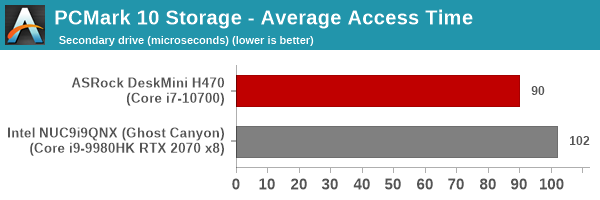
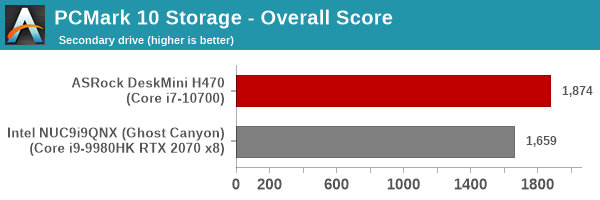
The second partition in the DeskMini H470 is still that of the Crucial P5 - despite the larger partition size and available free size, the numbers closely track those obtained for the primary partition - bandwidth around 301.5 MBps and an average access time for the workloads around 90us. Here, the compared drive in the Ghost Canyon NUC is the Kingston KC2000 - a more like-for-like comparison drive against the Crucial P5 SSD. Both drives are M.2 2280 PCIe 3.0 x4 NVMe drives with 96L 3D TLC flash and use a SSD controller with external DRAM support. Kingston has since replaced the KC2000 with KC2500, but the 1TB version still carries a distinct premium over the Crucial P5 (around $0.18/GB compared to the $0.13/GB) despite the P5 delivering better storage performance as per the PCMark 10 storage bench scores.
On the networking side, we restrict ourselves to the evaluation of the WLAN component in mini-PCs. Since the DeskMini H470 review sample didn't come with any Wi-Fi card, we do not have any iPerf3 benchmark results for the system. The unit has a single wired gigabit Ethernet port, good enough for networking duties in a standard PC. Consumers contemplating the use of the system for networking-focused applications such as firewalls or routers have better options available in the market.


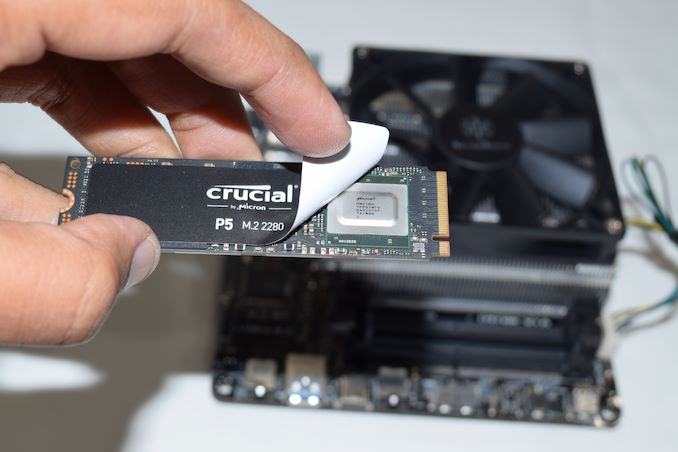








26 Comments
View All Comments
Tomatotech - Tuesday, December 29, 2020 - link
That’s possibly one of the best possible arrangements for the m.2 slot then as the metal tray will be an excellent heat sink. You could even add a bit of thermally conductive foam (make sure it’s not the electrically conductive type) to help with heat transfer to the tray.ganeshts - Tuesday, December 29, 2020 - link
The Ultra M.2 slot is on the top side of the board. That is the one used with Comet Lake CPUs. The slot you are referring to is the Hyper M.2 (PCIe 4.0 x4) slot which is usable only when the Rocket Lake CPUs come around.twotwotwo - Tuesday, December 29, 2020 - link
Its AMD relative the A300 was my main machine for a while, and had it been easier to get Zen 2 desktop APUs I might still be using it. Quiet (given a decent fan), cheap, tiny (obvs), reasonably expandable, gets the job done--about all I can ask for from a work desktop.Death666Angel - Tuesday, December 29, 2020 - link
The 4000 Series Pro APUs are pretty well available in Germany, from reputable online retailers. I can get the R5 Pro 4650G for 20% more than the equivalent R5 3600 (200€ vs 240€ roughly). That would be my sweet spot, personally. For 8 cores it's also roughly 20% (280€ vs 340€) but for that price difference, you could get a nice used GPU already that will maybe game better. I personally could never justify a GPU-less build, although I am eternally curious about them and plot one out once every couple of months.... and then I look at benchmarks of dGPU vs iGPU and stop. :DTomatotech - Tuesday, December 29, 2020 - link
I didn’t see it in the article so here are the specs:155 x 155 x 80 mm (1.92L)
Not bad, though for most low to mid-level use cases it’d be far cheaper to buy a used Lenovo or Dell USFF PC - these have even less volume at around 1.1L but are slightly larger and flatter (around 180x180x35mm)
For SFF with GPU I still prefer something like the K39 mITX chassis on the low end which comes in at 3L but allows you to use most full-sized GPUs (but for now possibly not the nVidia 3000 series).
Samus - Tuesday, December 29, 2020 - link
I've been rocking the FT03-Mini and while it is an absolute nightmare to work inside of (and I question my sanity for why I put myself through owning it) it is still a very effective ITX chassis for the size, capable of 10.5" videocards, multiple hard drives (plus two m2 drives you can mount to most current motherboards) while using a single 140mm fan to cool everything. Realistically the highest TDP CPU you want to use is around 88-watts as anything more you will stress any closed loop cooler with a 25mm radiator (the max the case can accept) and need to go to a heatsink of some sort with another dedicated fan.Obrut - Tuesday, December 29, 2020 - link
It will be interesting to see a comparison with ASRock Jupiter H470, which has a much different form factor and cooling solution.M O B - Tuesday, December 29, 2020 - link
I have a Deskmini 310w--is the UHD 630 on 10th gen CPUs any faster than the UHD 630 on older CPUs?If not, then it seems like this iteration basically adds some USB 3.0 ports versus my current build.
ganeshts - Wednesday, December 30, 2020 - link
I think the additional angle here is that of a low-cost platform that can take advantage of the RKL-S CPUs coming in 2021. Personally, I also think it is not a great choice to upgrade for those who already have the 310. It is meant more for folks getting their first mSTX machine.Samus - Tuesday, December 29, 2020 - link
I had the SST-AR11 cooler in my Silverstone FT03-Mini and was pretty disappointed (partially due to the chassis inherently poor ventilation) and equally disappointed by closed-loop coolers due to the 25mm thickness limitation of radiators. After spending seemingly hundreds of dollars and way too much time hunting for a thermal solution, some forum posts directed me to try the NT06-Pro, which would theoretically fit this mSTX chassis as long as there is no interference with the power supply.It performs incredible well as you position the fan under the fins and blow the heat away from the motherboard instead of onto it, giving it somewhat of the beneficial effect of a tower-style cooler.